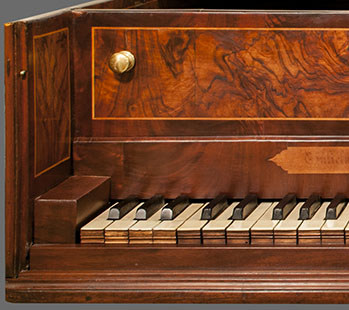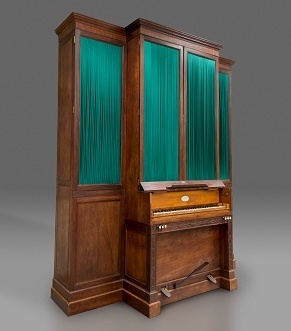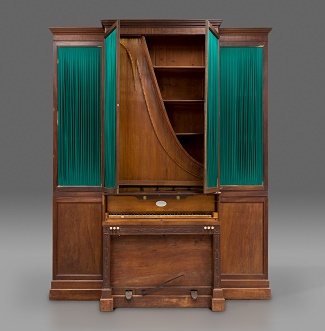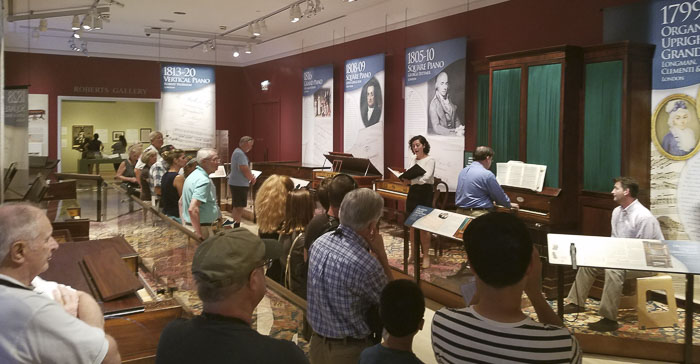
Early Keyboard Ventures
and related speculations by John Watson
Longman, Clementi & Co.
Organized Upright Grand Piano
(London, 1799) The Colonial Williamsburg Foundation -- Accession no. 2012-150


After-treatment photos by Jason Copes, The Colonial Williamsburg Foundation. All rights reserved
In 2012, The Colonial Williamsburg Foundation acquired this organized upright grand piano made by the Longman, Clementi & Co. in 1799 and first owned by the Tucker family of Williamsburg, Virginia. After spending only three years in Williamsburg, the instrument was transfered to Charles Carter of Shirley, a plantation on the James River. By 1807 it was transferred again to the Walker/Rives family of Castle Hill plantation in Albemarle County, Virginia, where the instrument stayed until 1947. After 55 more years, mostly in warehouse storage, the instrument returned to Williamsburg were it received thorough restorative conservation. Jenna Simpson researched and summarized the instrument's interesting social history.
The restoration took place in the Instruments Conservation Lab at The
Colonial Williamsburg Foundation (CWF). Under the direction of conservator John
Watson, the project implemented principles of restorative
conservation as defined in Watson's book
Artifacts in Use: The
Paradox of Restoration and the Conservation of Organs
(Organ Historical Society and CWF, 2010) The Tucker organized upright grand piano is now fully playable, probably for the first time
since the early 19th century, and is on exhibit in the Museums of
Williamsburg where it is used regularly for demonstrations.

Colonial Williamsburg musician Daniel Corneliussen with vocalists in first
public demonstration of the organized piano.
- Haydn Adagio CMaj Sonata (piano & organ together)
- Haydn Adagio E-flat Sonata (piano alone)
- Haydn Finale Allegro E-flat Sonata (piano adding organ)
- Handel Larghetto (organ alone)
- Handel Allegro (organ alone)
(begins with piano alone; then organ alone at 6'30", then piano and organ together at 8'30")
Photo Albums

|
Picking up the pieces from storage in Richmond, VA (11 photos) |

|
First steps in conservation of the casework, organ, and piano (12 photos) |

|
Conservation of the bellows and chassis (14 photos) |

|
Conservation of the wind-chest (30 photos) Also, this video shows a new method of measuring gaps within the chest for non-invasive shimming to stop leakage of wind from note to note. |

|
Conservation of the pipework (14 photos) |

|
Conservation of the upright grand piano (31 photos) |

|
Reproduction piano action (39 photos) |
For more information
This preliminary article about the instrument was published in the
Journal of the American Musical
Instrument Society
.
The instrument had been very well preserved, though in a non-playing state
for most of its career. The lead-alloy organ pipes, however, had been badly
mangled and were straightened out with Lou Dolive playing the most important
role. These videos show the
method and the
results.
Also, the piano action had been discarded very early in the instrument's
history, probably due to the complexity of keeping the combination
instrument in regulation. A reproduction action had to be made (see
action model video).
The design of the reproduction action was based on 1990s drawings by David
Law of the
1804 Clementi upright grand
piano
formerly in the Finchcocks collection. David's drawings were in
preparation for John Secker's reproduction action for an 1806 Clementi
upright grand piano for collector Kenneth Mobbs.
The trapwork for switching between piano and organ was mostly missing. This
video shows the reconstructed trapwork
before and
after engaging
with the organ. To play the piano and organ together, a handstop for
switching between them is moved to the piano position, then the organ
is added by means of the pedal. This
video shows the
action of that pedal.
Installation day at the museum is partly captured in video 1 and
video 2. This
article in the Virginia Gazette
tells more about the organized piano and its context in the Changing Keys
exhibit.
Conservation of the Tucker organized piano was made possible by a gift in memory of N. Beverley Tucker, Jr. and the work of the following dedicated conservators and specialists:
- John Watson—Project Conservator
- Lou Dolive—organ and pipe treatments
- John (Jay) Gamble—reproduction piano action etc.
- Tom Winter—reproduction piano action
- Albert Skutans—furniture conservation
- Jenna Simpson—research
- Christopher Bono—organ voicing
- Steuart Goodwin—Organ voicing
- Lorie King—reproduction piano action
- Leroy Graves—door upholstery conservation
- Elizabeth Mallin—door upholstery conservation
- Chris Swan—furniture conservation
- David Blanchfield—Turning, initial pickup, management
- Jennifer Schnitker—conservation
- Kirsten Moffitt—materials analysis
- Astrid Smith—furniture conservation
- David Shakibnia—conservation technician
- Caitlin Sofield—furniture conservation
- Emily Williams—radiography
- James Zilius—initial pickup
- Patricia Silence—initial pickup
- Trip Kahn—furniture conservation
- Linda Baumgarten—textile analysis
- Coleman Hutchins—furniture conservation